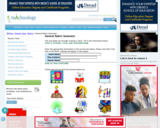
An online tool for creating rubrics.
- Subject:
- Education
- English Language Arts
- History
- Math
- Science
- Social Studies
- Material Type:
- Assessment
- Date Added:
- 09/26/2019

An online tool for creating rubrics.

"This tool allows you to create presentations, infographics, video presentations, resumes, and more.
It includes many templates with access to photos, animations, and illustrations giving the user the ability to make any image or text interactive.
Content can be shared through a link or downloaded.
Teachers can make materials to share with students or other teachers, and students can use to build resumes or design a product for summative assessment." (AASL)
The gamification options look really good within this tool. You (or your students) can make a variety of different games to test content.
There are some great product choices in here to demonstrate learning.

Educational Scavenger Hunts for the 21st Century!
This app helps you facilitate scavenger hunts, where teams of students compete to find items you assign (in the physical world), then take photo evidence at each point and post it on the app. The app then keeps track of team points so you know which team won by the end.
This tool could be used for teams to complete assessments, or to provide feedback and capture an snapshot of their current level of understanding of the material. Students could also CREATE these for summative assessments to share with their peers if centered around a topic of study in the classroom.
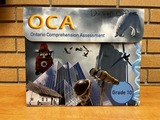
This resource is created to support Grade 10 teachers in Sun West with the Pre and Post Reading Assessment that is done every two years. In additions to supporting the assessment process, there are best practices for using Before, During and After Reading Strategies in our ELA classrooms.
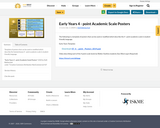
Template of posters that can be used or modified which describe the Saskatchewan 4 - point academic scale in student-friendly language.
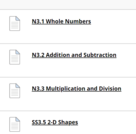
Sample Math Outcome Questions: An Assessment Resource for Teachers.
The resource Sample Math Outcome Questions: An Assessment Resource for Teachers:
• provides possible questions, sample responses and rubrics for classroom instruction and assessment.
• is not mandatory.
• was created to support the teaching and learning of mathematics.
• can be adapted by teachers to meet the individual needs of their students.
• can be used before, during and/or after classroom instruction as formative or summative assessment(s).
• is designed to elicit responses that inform teachers’ understanding of the skills and concepts that students need to know, understand and are able to do.
This resource primarily assesses students using written response. Indicators that include terms such as research or collect data (for example) are ideally assessed by means other than a written response. Subsequently, teachers must keep in mind that using this resource provides only one of many forms of evidence that teachers collect to report on student achievement of the outcome.
Each sample includes the outcome, indicators, sample assessment and answer key.
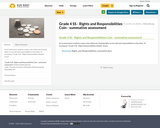
As an assessment, students create a two-sided coin showing rights on one side and responsibilities on the other. To accompany "Grade 4 SS - Rights Responsibilities Mobile" lesson.

This resource is created to support Grade 7 teachers in Sun West with the Pre and Post Reading Assessment that is done every two years. In additions to supporting the assessment process, there are best practices for using Before, During and After Reading Strategies in our ELA classrooms.
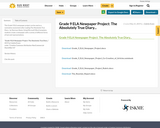
This Grade 9 ELA newspaper project can be used as a summative assessment after reading The Absolutely True Diary... by Sherman Alexie. Using Microsoft Word templates, students create a newspaper with a variety of different forms of text and representations.

These tasks, rubrics and exemplars support high quality instruction and assessment. They have been adapted by Horizon School Division Grade 5 teachers.

This webinar will explore best practices around feedback and how it can best be utilized to impact student learning.
Presented by John Almarode, Douglas Fisher, Nancy Frey.

This article from Edutopia examines "What happens when students can opt to skip tests and instead give oral presentations or create art to show what they know?"
This is a good article to get teachers thinking about assessment in new ways.
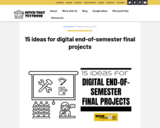
Final projects can help students summarize and review content from the entire semester. Plus, they can create fantastic products with what they've learned!
Projects let students take what they’ve learned, put it all together and show off a little of their own creativity and personality.
Options include:
1. Create a website
2. Create a screencast video
3. Make a single multimedia webpage
4. Connect with a cause
5. Create an infographic
6. Create a series of podcasts
7. Do a genius hour-style project
8. Create an annotated collection
9. Tell it as a story
10. Make an explainer video

The tools for educators include:
~ Problems of the Month - The Problems of the Month are non-routine math problems designed to be used schoolwide to promote a problem-solving theme at your school. Each problem is divided into five levels of difficulty, Level A (primary) through Level E (high school), to allow access and scaffolding for students into different aspects of the problem and to stretch students to go deeper into mathematical complexity.
~ Jumpstart Guide for Practitioners - guide to accompany the Problems of the Month
~ Formative Re-engaging Lessons - Formative Re-Engaging Lessons involve a cycle of inquiry, instruction, assessment, analysis, selection, and re-engagement around a mathematical concept. Each Formative Re-Engaging Lesson includes a classroom video of the lesson, downloadable lesson plan, student pages, pre- and post-assessments, and supporting instructional materials.
~ Classroom Videos
~ Resources for Social and Emotional Learning in Mathematics Classrooms
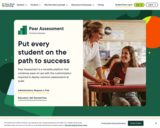
Put every student on the path to success!
Identify gaps, help students learn and measure growth all in one easy system. In the classroom and at home.
Quickly identify learning gaps with diagnostic and formative assessments.
Give students differentiated assignments to remediate, reinforce or challenge.
Monitor progress towards standards mastery to ensure students stay on track.

Kahoot! is a game-based platform that makes learning awesome for millions of people all over the world. Sign up to create and play fun quiz games!
Having students make quizzes on Kahoot! is a great way for them to extend their learning and benefit the entire class!
Kahoot! is an excellent formative assessment tool. You can give feedback to your students after each question as you play. Make learning a game show...your students will never have so much fun being assessed.
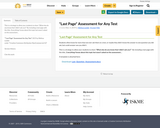
This is a strategy to allow your students to share "What else do you know that I didn’t ask you?" By including a last page with the title...Everything I know about this topic but wasn’t asked on the assessment…

Thinking of students on different pathways to learning can help us better understand Personalized Learning.
Implementing learning pathways can help teachers to "adapt to each student’s learning progress, motivation and goals".
In the example given (and there are many more versions you could use!) Students are on 3 pathways. All pathways get small group instruction!
Pathway 1 - these are the students that are usually ahead. They skip over some things and get into the deeper work.
Pathway 2 - the "core" track for students working at level.
Pathway 3 - these students may have gaps or work more slowly. They don't get MORE work, but work at their level. They will likely get more small group instruction than the other paths.
Formative assessment is used on all pathways to improve instruction and learning.
*students can move between pathways if desired or necessary!
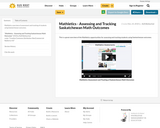
Mathletics overview of assessment and tracking of students using Saskatchewan outcomes.

This 10 minute video will explain how you can find, schedule and use the Saskatchewan Assessments housed within Mathletics with your students. These assessments can be used to support your work with Personalized Goals (PGs), classroom instruction and your other assessment needs.